We all wish that we lived right on the beach and could drag our kayak down to the water and just start paddling. This is not the reality for most of us. Most of us have to drive our car with kayaks/canoes to the water and then portage them to the edge. So kayak transportation becomes a huge part of being into kayaking. You can rest assured that you can make any dry spell in a new kayaking-buddy conversation easier by discussing roof racks for an hour or two. Everyone has their opinion on what works for car topping a kayak and why.
Choosing a kayak roof rack has been an expensive endeavor for me. Let me just say this outright, Yakima and Thule make very good money off of us as consumers. This isn’t to say that their income isn’t well earned. A great car topping system for your kayak is worth every cent. But arriving at the final configuration for a great roof rack system took me around $600-$800 dollars. This is because I went through several configurations on different vehicles before arriving at the optimal system.
I hope it will only take you roughly $380 to get the perfect kayak rack system. For a new kayaker this is always a big source of anxiety. We all worry about wind noise, the kayak flying off, being able to lift the kayak easily onto the bars etc. Hopefully this article will help waylay some of these initial anxieties.
There are roughly speaking seven basic components for any roof rack system. I am going to list them and then break them out individually.
- Your car
- The towers
- The bars
- Pads, cushions, saddles, rollers etc
- Straps and lines
- The kayak
- You
Your car
Figure out which car will carry the kayaks 99% of the time. Ask yourself these questions:
- Will I put stinky neoprene inside this car on a sweltering summer day to bake into a hot funky pie?
- Can you even reach the roof of this car without a ladder?
- How many kayaks can you fit on the roof?
- How many kayaks will you be carrying most of the time?
- Can you fit one piece paddles in the car without them interfering with the gear shift?
- Can you bear to have this car scratched up when you miss the rack with the kayak and chip the paint?
After asking yourself these somewhat serious questions. Once you arrive at the answer of which vehicle, if you have more than one; consider these factors.
Height makes a big difference for which vehicle I chose. I am only 5’7″ tall and I cannot car top my kayaks on my minivan without a step ladder. That’s a fact. For some people that is too much hassle. For me it is just part of the process. For some people they are not strong enough to lift their 65 pound plastic kayak onto a minivan from a step ladder without dropping the kayak or injuring themselves. Remember the object is to get to the water and paddle, not dead lift a 65 pound kayak to an 8 foot cargo van. So consider height very seriously before selecting which car you will choose for your shuttle vehicle. There are however some accoutrements for aiding smaller paddlers with larger vehicles that I will get to later in the Pads, cushions, saddles, rollers etc section. I will say this flat out, shorter cars like my 1993 Volvo 240DL with wide flat roofs are ideal for car topping.
The number of kayaks you will carry is another huge factor. There is a reason you see so many Subaru Outbacks carrying kayaks. They have long low flat roofs that are easy to load. I personally don’t have the scratch for a 28k all wheel drive wagon. A van though, despite the height problem will carry even more kayaks than a minivan. The limit I have gotten on my vehicles has been six kayaks on their side. If this is going to be a likely occurrence to shuttle 4-5 people. A wider flatter roof that is lower to the ground with kayaks carried on the side is the right choice for you-think station wagon. However if it is mainly you and the mr./mrs. on Saturdays-this isn’t really necessary.
The rack options for pickup trucks have gotten really good in the last few years. And with a smaller pickup that is lower to the ground you really have it made. You can throw all of your gear in the back of the truck and top your kayak pretty easily. The Ford Ranger, GM S10, or Toyota Tacoma come to mind. A cap for the bed complicates, but does not remove the option for topping your kayak.
Without getting into a philosophical debate. SUVs are about on par with minivans. SUVs are typically taller without any greater car topping ability, nor additional cargo space.
Smaller cars do limit your options for the number of kayaks. A really small car like a Scion XB, or a Honda fit will carry kayaks just fine. But you are not going to be able to top 4-5 kayaks even on their side with the same ease that you would say with a 1993 Volvo wagon. Also note that if you are carrying a double, or a homemade boat that is an Aleutian triple, all bets are off for smaller cars.
Roof types is a really important factor when considering which vehicle to use for car topping your kayak.
First the types of roof shapes and designs are really important because they determine a lot of your options for what type of rack you can get, and how many kayaks you can carry. I describe here the two ends of the spectrum. Rounded and short and wide flat. There is obviously a lot of in between.
Rounded and Short Car Roof

The rounded and short roofs make it hard to load lots of kayaks. They also have to use a specific type of tower to mount the bars to. I will cover this later on too. But let’s just say the door jamb mounted towers are not the most reliable of the four or five types of basic towers. And with a short rounded roof you have shorter bar spread which leads to issues while driving down the road with an 18 foot sea kayak loaded to the car. It is not ideal.
But it can be done. Don’t despair.
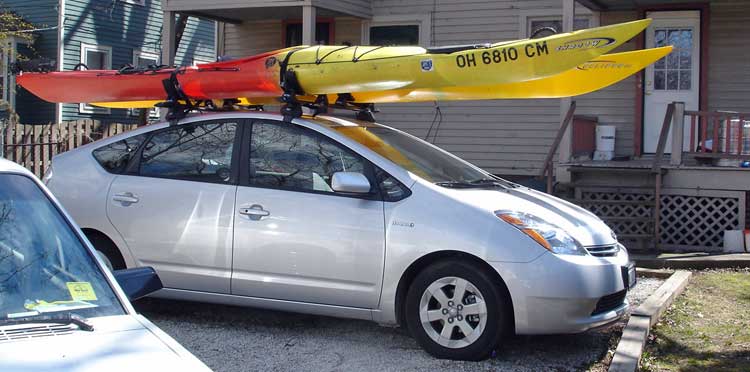
Flat and Wide Car Roof
Low cars with wide flat roofs are ideal. I know this is not what most Americans will want to hear as we own a lot of SUVs and pickup trucks. As I said before wagons are really ideal due to being low to the ground, long, wide and flat.
Pickup Trucks
Pickup trucks can use bed posts and rails. Check out this image of a pickup truck carrying kayaks.
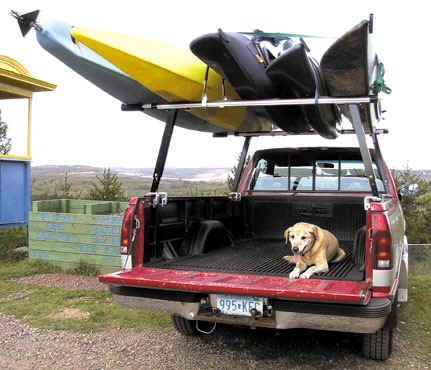
Thule appears to make a great rack system for the bed mounts.

Other than the height challenge, these could really be advantageous for carrying lots of kayaks. Get a step ladder if you are short for this system.
Other Factors
Obviously mileage, cost, and other factors do come into play for selecting the right vehicle for car topping as does the terrain you will be driving in most frequently. If you will be doing dirt, gravel, forest service roads, please consider an SUV or AWD vehicle for car topping.
The Towers
The towers simply put are where the rack attaches to the car. There are a few basic attachment types and they are dependent on the type of car and roof attachment point you have. This is also why I described the two ends of the spectrum for roof shapes prior to this. These are the attachment types:
- Naked Roof-this is cars, vans, or trucks with no factory rack, no rails, or cross bars. These are potentially the worst type of attachment point for any car. You have to depend on a door jamb clip from a tower. Yakima calls this a q-clip. These are the least secure and have very little torsional rigidity compared to a factory rack, the permanent drill through type, or raingutter racks. I personnaly dealth with 4-5 customers from Lee’s in Kalamazoo whose rack came off the car. All of them were the naked roof variety. This is not to say they are not viable, or safe, but they require constant vigilance. You must pay attention to the tension of the clip and tower on every trip and watch them carefully. This is good advice for all roof rack mounts, but especially so for the naked roof variety. I have the naked roof variety on my Dodge minivan, and I have to say it sucks. I much prefer either factory roof rack mounts, or raingutter to this type. These are also a little more complicated to assemble and attach. You really have to be careful when measuring and attaching these racks to make sure everything is even and straight. Often the spread, (distance between the bars when mounted) is too narrow which really makes for a very flimsy setup.
- Factory Roof Rails-this type of attachment is for vans, wagons, or suv’s with rails running parallel with the length of the car. Without hesitation I will say that these are the easiest, best way to attach a roof rack. The towers made for these roof types are the most solid and can bear the most torsional force compared to the naked roof. They are also the easiest for the consumer to assemble out of the box. You do have to pay attention to the load rating which the auto manufacturer will typically list in the owners manual. Most of them are around 200-300 pounds. So if you have a big minivan that you can stack 4-5 kayaks on with maybe 10-20 pounds of gear or whatever in them, you might come close to that weight rating.
- Factory Crossbars-These sort of suck. I would really avoid loading any amount of weight on these if you can avoid it. The auto manufacturers usually rate these at about 100 pounds max. The bars are often flimsy and too close together to be able to distribute kayak(s) properly. Often you will see someone using the naked roof setup over the top of the factory crossbars so as to have more spread and load capacity.
- Permanent-for pickup truck cabs and campers-these can be very solid. If you have a pickup cab I would really think carefully about having a professional do the work so that you can at least blame somebody for screwing up the roof when they drill the holes wrong. Seriously though, these are the most complicated setup, but probably the most sturdy apart from the factory rack. You can typically get a really good spread, and they will bear a fair amount of weight.
- Raingutters-are an older style of mount. My 1993 Volvo has them. I really like them. After factory rails these are the best option. They are super easy to attach, and will bear a lot of weight. If you can score an older car with these for a shuttle vehicle you will agree with me pretty quickly.
Images of the various types of attachment points:
Naked Roof

Factory Roof Rails

There are a variety of towers made for almost every car on the market. The towers and the clips.
Factory Bars

Permanent

Raingutter

Yakima and Thule both have excellentapplications for determining which setup you will need for your car. The fit for each vehicle is different. I would highly recommend going to these sites and using these applications and then finding a local retailer to help you get a fit. If you are in my neck of the woods, (Kalamazoo) Lee’s Adventure Sports is possibly the best place. They will actually do the fit for you.
The Bars
The bars are really crucial for any setup. Here are some factors to keep in mind for getting the right set of bars.
Length
The length depends on the width of your car. Again Yakima and Thule have web applications to help you pick the right bar length. I would recommend, if possible always going one size longer. This has it’s upside in that you can always put one more boat on. But you then have to be careful on smaller cars not to hit your head on the bars when getting in and out of the car.
Spread
As mentioned before the spread, or distance between the bars is critical for getting a good strong fit between the kayak and the car. And this is where longer, wider flatter roofs still make it much easier to get a good strong contact between the car and the kayak. If the spread is too narrow, the wind tends to get under the boat and shift it around. It is generally makes life harder. The only area where too wide is a problem is for smaller kayaks such as white water kayaks, surf kayaks, and squirt boats. If is too wide, the shorter boats will not fit on the bars. So pay attention the spread when purchasing and keep in mind your shortest kayak.
Bar Shape
I will come out and say that square bars from Thule are better. When you are pushing a kayak from the rear of any car, the round Yakima bars always cause pads, rollers, stackers what have you to twist in an inconvenient way.

Pads, cushions, saddles, rollers etc
There are really only two ways to carry a long skinny object. On it’s side. Or flat. This means that really the two types of systems are saddles and stackers with variations.
Image of Saddles
Stacker
There are various merits to the aerodynamic aspect of carrying a kayak flat. That said. My general feeling is that the saddle, rollers, and cradles etc are a waste of money.
They all really do the same thing as a foam pad. Foam pads are economical, easily transferable between vehicles, easily replaced when damaged, lost or stolen. They do the job, no more no less. My personal preference is to use a stacker for high capacity loads. And then I use foam pads when I am only carrying one or two boats. Kayaks are structurally stronger on their sides anyway. I have 4 kayaks. And I sometimes carry all of them on vacation. The only way to do that is with a stacker. I also have carried up to six sea kayaks on my Volvo for friends the stacker is what makes this possible.
This is merely my editorial opinion, and I welcome comments about the various accoutrements. This is however my opinion after having used all of these products:
- Saddles really don’t do anything that a foam pad can’t do. Saddles take up more width than a foam pad and don’t offer any more security than strapping the boat to the pad. When these are on the bar, you are limited to carrying one boat in what could potentially carry two kayaks on their side.
- Rollers are sort of useless. They never provide as much mechanical advantage as one might think. Being able to roll the bow of a kayak up on the rollers is just as hard as pushing a kayak on a foam pad. Also it is a smaller target area to hit with the bow of a long heavy sea kayak and therefore easier to miss, and then cause additional frustration when loading. These also have the same problem as the saddles, they take up more room on the bars if you need additional carrying capacity.
- J cradles are really just expensive stackers that take up more room. They do provide a bit more stability than a stacker, but they also make it a bit harder to load. You can’t load from the rear of the vehicle and push without torquing them forward. (especially on round bars).
Just to let you know I started out with rollers, went to saddles, then j-cradles, and have ended up with foam pads and a stacker. So I did try all of them! In short foam pads and stackers are your best value for capacity and easy of use.
I know that some people are skeptical of the stacker and foam pads due to concerns for wear and tear on expensive sea kayaks. But let me assure you that your pristine and very expensive glass/carbon kayak can always be padded out, or put deck out to prevent scratching when carrying many boats.
Straps and Lines
Bow tie downs should always be used when carrying sea kayaks. I don’t use them for surf kayaks or white water boats. I prefer shorter straps when carrying one or two kayaks, and then two super long 12 foot straps when carrying many kayaks. Try to pay attention to the care of straps and make sure to replace them when frayed so your kayak doesn’t fly off the car when going down the road. A truckers hitch knot is your best friend for tying a bow line to the frame of your car.
Good tension on the straps is important. Make sure to guide your straps on the inside of your towers where possible for extra security. Tie or fold out extra length in your straps to cut out extra wind noise.
The Kayak
Each kayak is different. Make sure when selecting your bar spread, and your straps that you keep width and depth in mind as well as length. If you are carrying whitewater boats, you have to make sure your spread is not too wide on your bars. If you are particular about the appearance of your car and kayak, carry a pad, carpet square, or towel to pad the roof as you slide the kayak up to the bars. Also make sure you clean your boat off before loading it if you don’t want your straps to chafe against the kayak.
You
The beginning part of selecting a roof rack system is simple. What can you lift, what can you reach, what is going to work to get you out on the water. Only you know. The guys at REI/Lee’s/Moosejaw, or wherever can’t help you with that. You have to do some diligence and figure out what is going to work for you.
Assisted Lift for Kayaks
This video demonstrates the Thule Hullavator Product.
This system is great if you don’t have the dead lift ability to get a heavy sea kayak up to the rack. Also keep in mind that if have a taller vehicle a small step ladder can save you oodles of time. It is what I use when carrying kayaks on my minivan. I am also not shy about climbing on the roof.
Home Made Racks
I have seen some great home made racks. Jeff Laxier had the best truck mounted surf kayak carrier I have seen yet. It was basically a ladder rack with 2×4’s padded out with carpet. If you are handy and ingenious you can save a ton of money and make something great.
If you have a great home made rack, post me a link with a picture, I’d love to post them.
Summary
I obviously have a bias towards smaller cars with either raingutter racks, or factory roof rails. I also have a huge bias towards the simple foam pads and stacker setup. This has been my experience over my 8 years of paddling and trying what didn’t work. One thing I didn’t cover is trailers. Trailers make life a lot easier for loading. But obviously complicate maneuverability and parking. They are also very expensive, even used. Unless you have welding skills and equipment making a trailer is not an option. But I would also like to hear from those with trailers.
Doug Coster forwarded these images and the description below to me via email. I added them to share with you:
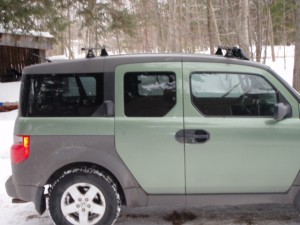
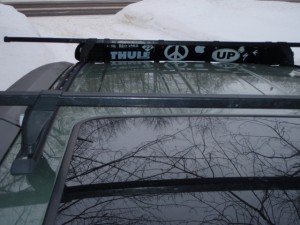
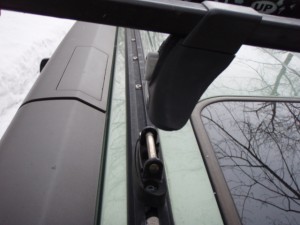

Hi, I enjoy checking out your blog. While working as a retailer I came across a different possible rack configuration. I installed tracks as did a few of my friends to provide a wider than stock, and adjustable bar placement. The tracks are available in different lengths from Thule and Yakima and are the same extrusion. The attached photos are of Yakima tracks with Thule TK towers/feet. We have used 2 different local body shops and had pro’s install the tracks for about $100. I purchased the longest Thule bars as they are made of thicker material and cut them to about 68″. Four sea kayaks is doable but 3 is more comfortable. Feel free to use the photos. I have been using this system for 4 years and lots of cross country travel with sea kayaks and hang gliders.
Thanks for your efforts.
Doug
Random note:In the research and collection of imagery for this article I ran into Astrid Fingerhut no less than seven times. Guys if you are single and looking for someone to hike, kayak, and drink red wine with. I think you want to look Astrid up, she likes funny insightful people.

had never heard about something like this. thanks for sharing it.http://www.plactual.com
I simply couldn’t depart your site prior to suggesting that I really enjoyed the usual information a person provide on your visitors? Is gonna be again continuously in order to investigate cross-check new posts
Thanks a bunch for sharing this with all people you actually recognise what you are talking about! Bookmarked. Kindly also seek advice from my web site =). We will have a link change contract between us
While a lot of consideration has gone into the all the different types of roof racks the author does mention that his preferred method for “cradles” is closed cell foam.
If your kayak is a composite one and transported in a hot climate (summer temps of above 90F) chances are that a high end foam core epoxty kayak might deform in the sun. Yes, it is not just the palsti boats that have to be taken care of when hot, composites too.
My carbon/Kevlar clear coat kayak dimpled badly when transported on Thule cradles. Transporting on J cradles onit’s side did not improve that either. If temps are high transport your high end kayak resting on the deck (mine is vinylester) and with a perfectly shaped closed cell foam cradle.
The point about plastic boats and heat is a good one. I have two plastic boats. I always put them on their side, even when only carrying one.
As to high end foam core-Those too on their sides should be fine. I’ve had high end surf kayaks with foam core on my roof this way in the california sun with no deformation.
Great review!
Both Yakima and Thule sell rail systems as well – you attach rails to your roof, q towers and whatnots can be used for the rest. That is what Michael had on his Element. System allows the use of almost all the roof space for bar spread. Unfortunately, some drilling is required.
Here is how it looks on Prius: http://thulepriusrack.blogspot.com/
And, how could you forget Malones? 🙂 http://www.maloneautoracks.com/
I like malone, but they are primarily known for saddles. Which in my experience are fancy, expensive foam pads with less carrying capacity.
The prius install looks pretty serious man. You’d have to be pretty darn sure you got it right, cause if you don’t no body shop in the world will come near you to fix it!
Also it doesn’t eliminate the bar spread problem of the short rounded roof. But it is better than the door jamb solution I will give you that.
Thanks for posting the link to the blog!
Keith
Volkswagen has a nice system where the tower fits over a bolt under a gasket at the rain gutter.
One advantage of saddles is that they allow you to carry and SOF upside down. This is more aerodynamic, and the deck is stronger than the hull. I think you can get a better fit than with foam.
Tom:
You can always glue minicell foam pieces to the standard foam pads to carry a SOF upside down. Thanks for mentioning the aerodynamics. MY friend Doug Van Doren swears that he gets better gas mileage with his Betsie Bay Recluse upside down. I think it is probably true with upswept ends and all that.
Do you have a picture of the VW system? I’d like to see it?
Keith
You could of course consider towing a trailer 🙂
I really want a trailer for the minivan. I am sick of the roof rack on that particular car. I think a trailer would be better. They cost serious scratch I usually spend on kayaks. 🙂
Keith